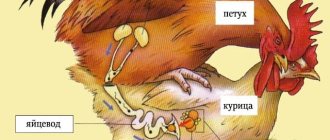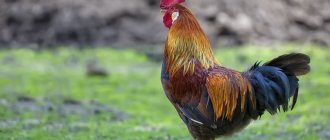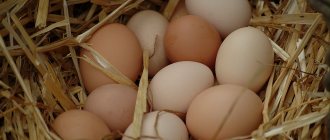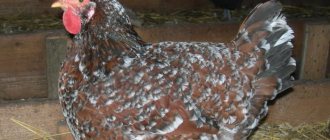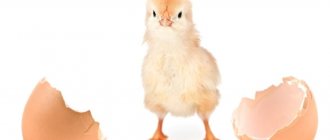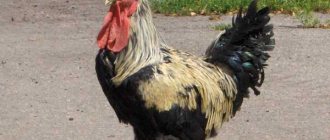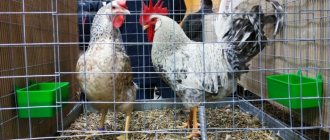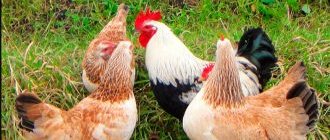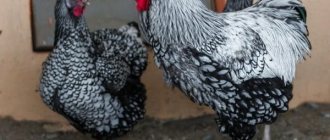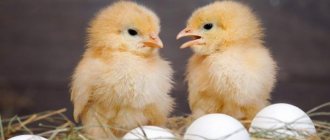Home » Articles about chickens » Do chickens need a rooster to lay eggs?
Organizing and maintaining a small chicken coop is not difficult: just arrange a barn, prepare a food supply, purchase chickens or young chickens. Once the laying begins, the owner’s family will be provided with fresh produce every day. But not everyone knows how necessary a male is in a herd, and whether laying hens produce eggs without a rooster.
Negative
It is believed that the rooster is the head of the chicken coop, who is not only a guardian and husband for the females, but also a boss and commander. Unfortunately, it happens that the male does not improve, but rather destabilizes the situation in the barn. He may behave too aggressively towards females, for example, driving them away from the feeder, and even hitting them. There are known cases when particularly malicious specimens pecked laying hens to death. It is better to immediately put such a gentleman into the soup, because it is impossible to re-educate him, and chickens living in constant stress will stop producing eggs.
However, aggression should not be confused with severity. To maintain discipline, the rooster may peck his subordinates to make them obedient. If you choose the wrong male or place him in the wrong coop, he is unlikely to become a leader. Chickens, especially older ones, can ignore him and initiate fights.
When a male is dominant, ambitious and diligent in his work, the birder should treat him with respect. If the bird thinks that a person is claiming power in the chicken state, he will be aggressive - first towards the owner, and then towards his subordinates.
Storing breeding chicken eggs
The fresher the eggs, the better the results during incubation. Best results from eggs no older than 5-7 days. After three weeks from the time the egg was laid, the percentage of hatched chicks drops significantly. Since it is not always possible to immediately collect a lot of eggs for laying under the hens and especially in the incubator, they have to be added and stored for some time. The number of hatched chickens depends on the skillful storage of chicken eggs. When storing breeding chicken eggs, the following must be observed:
1) Store eggs in a dry, ventilated area at a temperature of about 8° according to Réaumur
2) lay them out on tables or shelves in a lying position, in one layer
3) turn it over on the other side every day so that the yolk with the embryo does not stick to the shell; 4) protect from possible heating by the sun, which can lead to premature development
5) humidify the air in the room if it is too dry.
Positive
The presence of a feathered man in the chicken coop is not without its advantages. He has chickens with him:
- don't fight;
- do not make noise without reason;
- do not wander off while walking.
Caring male:
- makes sure that the ladies of the heart are not hungry;
- drives away girlfriends from the female, who is currently rushing;
- ready to repel uninvited guests in the form of rats or cats.
And of course, he tramples chickens so that they produce fertilized eggs. At the same time, its activity does not affect egg production as such.
The role of a rooster in a chicken coop: do chickens lay eggs without one?
All mature birds from 6-8 months (depending on the breed) regularly lay eggs. They are mature eggs. If at the time of its ripening the hen had sexual contact with the rooster, this egg will leave the body fertilized. If not, the egg will still mature and leave the body, but an embryo will not be formed in it. Thus, the hens will lay eggs regardless of whether there is a rooster in the coop, but they will not be able to give birth without one. Despite the fact that a rooster does not affect the egg production of chickens, its presence in the herd is very desirable. Read about the features of the Rall Island chicken breed in this article.
Some external factors can affect the process of egg production in a laying hen: problems with feed, sudden changes in temperature in the chicken coop, infections - anything that is dangerous to the health of the bird. The presence of a rooster has little effect on this process.
Read about diseases of laying hens and their treatment here.
How to choose a good rooster
To choose the right rooster, it is advisable to have information about its ancestors. If they were active, healthy and productive, the offspring most likely will be too.
It is important to pay attention to the appearance, as well as the age of the candidate. He must not be too old, have all the attributes of his breed, and also have:
- large and bright comb, with signs of good blood supply;
- strong, broad chest;
- straight, strong legs;
- fingers of the correct shape.
The young male has tubercles instead of spurs. The first thickening becomes noticeable by 5 months of life. A two-year-old bird has spurs of about 2.6 cm, and during each subsequent year they grow another 1 cm.
It should be borne in mind that the degree of development of spurs is influenced by the breed. So in bantam roosters they resemble needle tubercles, and it is impossible to determine age by the legs.
Males are selected for the tribe at the age of 5-6 months. At the same time, they look not only at their appearance, but also at their behavior. Suitable:
- has an active temperament:
- combative and cocky;
- behaves like the main individual in the yard.
This one is not afraid even of larger birds - turkeys, geese and ducks.
A proper rooster gives way to the hens at the feeder. He does not offend females, and tramples them without unnecessary aggression. A mature male of a light breed is ready to mate 30 times a day, and a mature male of a heavy breed – up to 15 times.
At the age of 5, sexual temperament begins to fade, and the ability to fertilize becomes worse. Usually, feathered cavaliers are not kept until this age, but are put under the knife 2 years earlier, until the meat becomes completely rough.
Characteristics of a Good Chicken
General
Let's figure out how to choose a laying hen.
Features of healthy birds:
- Good laying hens have dense plumage, without bald spots or bald spots. A sick chicken's feathers stick together and become contaminated with droppings near the cloaca.
- Choose active chickens. They refuse to purchase individuals that look sickly and are not suitable for feeders and drinkers.
It is a mistake to cull a bird immediately after purchase if it does not lay eggs. Moving is stressful for her. It is worth giving time to adapt to the new herd. It is recommended to introduce a little ascorbic or succinic acid into the diet to get used to new conditions.
Suitable age
When figuring out when is the best time to buy a laying hen, you should rely on preferences.
If you want to get eggs faster, buy chickens aged 20 to 26 weeks. By this time, the pullets have already begun laying eggs, gradually increasing the production of eggs.
Older chickens lay fewer eggs and are therefore not cost-effective to keep. Important data is presented in the article “At what age do chickens begin laying eggs.”
Dimensions and weight
Young chickens are able to immediately lay eggs after adaptation to the farmstead. The weight of a laying hen should not exceed 1.5 kg. The rule does not apply to chickens of meat and egg lines.
Excess weight indicates overfeeding and inability to lay eggs. A chicken that is too exhausted will also not show the expected productivity.
Plumage and skin
When purchasing, choose laying hens with shiny feathers. Although the nuances and time of formation of a productive herd are important here. A sickly chicken with shabby sides is not suitable for breeding. But this appearance does not always become a reason for culling.
Egg production is indicated by the bird's late entry into molting. As a rule, poor laying hens begin to molt in July, within 4 months. When selecting chickens for a flock, such individuals look more elegant.
Good layers lay eggs for a long time. Molting begins in early October. Such hens lay eggs better, spending body reserves on increased egg laying.
Also inspect the skin of the chickens. Smooth, pinkish skin indicates health. Soreness is expressed by flabby sagging integuments.
Belly, keel and thorax
Buy a chicken with a well-developed belly.
The laying hen has a voluminous belly, because she consumes a lot of feed and has a viable ovary.
Three fingers should fit between the pubic bones. The cloaca is dilated and moist in appearance. The chest with the keel is smooth to the touch, without deformations.
A bad laying hen is recognized by her bulging belly and compressed cloaca. Such individuals are not profitable to keep
Eyes
A good laying hen has bulging eyes with a characteristic shine. A tired, cloudy look indicates pain.
Beak and legs
Chicks have a rich yellow beak and legs. It is common for laying hens to lose pigmentation as egg production increases.
Comb and earrings
Increased egg production is recognized by a brightly colored, medium-sized scallop. Its size does not indicate egg quality. Here we pay attention to the intensity of the color.
Earrings should be developed, without bluish inclusions.
Definition of intersex
If you want to have productive livestock, you should take into account the concept of “intersex chickens”. Such chickens have characteristics of both a cockerel and a hen. This is the result of crossing closely related individuals.
These chickens are distinguished by a large rooster's head and paws with spurs. It is better to refuse to buy young animals that are not capable of producing eggs.
How to properly place a rooster
Before letting a rooster into the company of ladies, it is recommended to keep it in the same chicken coop as the females, but in a separate pen. It is possible behind a mesh partition so that the new head of the family smells of “home” and adapts. The chickens should get used to it too. For the first 2 weeks they will approach the fence, take an interest in the newcomer, and when they stop, the male can be replanted. It is better to do this at night, when the birds see poorly and are therefore calm.
You can organize it so that not the rooster comes to the hens, but they come to him. To do this, the laying hens of the future harem are temporarily taken from their original territories to another part of the chicken coop, and a rooster is installed in their place. After a few days, the family can be reunited.
A sexually mature, proven male with correct manners is allowed to be introduced into the coop immediately. Such a person will not fight with gossips, but he will quickly make it clear who he is and why he came, and he will also find justice for the disobedient.
The main task of the male is how necessary his presence is
The main task of a rooster in a chicken coop is to provide new offspring. Without it, chickens will only lay unfertilized eggs, suitable exclusively for human consumption. However, this is not its only function.
pros
Additionally, the rooster provides:
- Increased discipline in the chicken coop. Chickens usually behave more quietly when there is a rooster. The rooster makes sure that everyone has enough space in the nests, food and water.
- Protection from small predators, as well as from other birds . A rooster can not only make noise in the chicken coop when an intruder tries to break in, but he can seriously injure the predator with his claws and spurs.
- Aesthetics. These birds are usually more attractive than ordinary laying hens due to their bright feathers and crest; they decorate the chicken coop.
Read about how to feed laying hens at home in winter here.
You also need to remember that roosters gain weight very well. Therefore, it is advisable to raise them for slaughter.
Minuses
The presence of a rooster in the chicken coop has not only advantages, but also its significant disadvantages. These include:
- The emergence of maternal instinct in laying hens. If a hen has a fertilized egg, she stops laying eggs herself and prevents neighboring birds from doing so, starting to build a nest. This reduces the productivity of the entire poultry farm. Even if the chicken has live chickens, it will not be possible to cover the losses immediately, since the poultry farmer will need to spend additional money on arranging a poultry house for the chickens.
- Aggressiveness of the rooster. He can attack not only chickens, but also the owners of the poultry house, wanting to protect his offspring from outside attacks. The bird can cause serious injuries to humans, not to mention the fact that it will cause serious problems when removing eggs.
- Unattractive appearance of the herd. Chickens that are regularly trampled by a male may have shreds of feathers torn out, and they often have wounds on their skin that can fester.
Read about other reasons why chickens stopped laying eggs at the link.
Also, the presence of a male in the chicken coop can negatively affect the productivity of chickens, even if they do not produce fertilized eggs for some time. Laying hens, which are often driven from the roost, peck, call, and usually lay less often. This is confirmed by the fact that once the rooster is removed from the coop, the productivity of the flock can increase.
How to raise chickens
For fast and good growth of chickens, you must follow the following rules:
1) Pasture chickens on a spacious run, with good grass and shade from bushes or trees, where chickens can hide from the scorching rays of the sun. Chickens are growing well
and grow stronger when moving in the fresh air, with an abundance of green food, as well as animal food rich in protein, such as worms, snails, larvae, insects, etc., which promote growth.
2) At night, place the chickens in summer, preferably portable, poultry houses with good ventilation so that they do not suffer from stuffiness on hot summer nights. Perches in these houses should be made only when the chickens reach 4 months of age, so as not to cause curvature of the still immature sternum crest.
3) Avoid crowding in poultry houses. On average, you can house about 50 chickens in a house measuring 1.8 X 2.4 m. The floor of the house is covered with dry litter, preferably from. straw. The litter needs to be changed at least once a month.
4) As soon as it is possible to distinguish cockerels from hens, it is better to separate them by placing them separately. The chickens then develop better. Of the cockerels, the best are selected for the breed and placed separately, and the rest, which will be sold or fattened, can be kept more crowded.
Feeding the chicks
The best first food for chickens to learn to eat on is crushed oats. The shiny white oat particles easily attract the chick's attention, and the mother herself helps the chicks find food. There is no danger from oat films, since chickens do not peck at them. Next chicken feed
- bread crumbs soaked in milk with the addition of finely crushed eggs with shells, as well as cottage cheese. As a grain feed, in addition to crushed oats, finely crushed wheat and millet (in the form of porridge) are good for chickens. It is also good to give wheat bran. Until the chickens are released onto the grass, they should be given fresh, finely chopped clover and sprouted oats. This green food is sprinkled on top of the given food. You can also place a piece of turf with fresh grass, which the chickens learn to peck.
The rules for feeding small chickens are as follows:
1) Feed more often and little by little. The first week 5 times a day, then 4, and by the end of the second week reduce to 3 times.
2) Do not overfeed the chickens so that they have time to get hungry before the next feeding.
3) It is possible to give the first food earlier in the morning, and the last one later in the evening, in order to shorten the night gap between the last evening and first morning feeding
4) Give only clean and fresh food so as not to cause intestinal upset (diarrhea).
5) Always keep fresh, clean water in front of the chickens, as chickens grow quickly and therefore need water. Until the chicks are weaned from the hen, it is good to sprinkle the hen with insect powder once a week or two. In wet weather, do not let the hen and the chickens out for a walk, especially at first, until the chickens are strong enough. Weaning chicks from the hen
occurs when the chickens begin to behave completely independently. The hen is returned to the coop where she can soon begin laying eggs.
Features of fertilized eggs
Fertilized eggs have a number of characteristics. Among them:
- The possibility of a chicken emerging from an egg, provided that the laying hen hatches it.
- Increased amount of useful substances in the product.
- Long shelf life. Fertilized eggs, if conditions are met, are stored for up to 30 days. However, they are considered dietary only for the first 5 days.
It is fertilized eggs that can be used in medicine. They are used to prepare medicines. For this purpose, extracts from 9-day-old chicken embryos are used.
To determine whether an egg is fertilized or not, it is enough to illuminate it through an ovoscope. If during this test you notice a red blood clot in the yolk, it means it has been fertilized. Otherwise, we can assume that the egg was not fertilized.
It should be noted that ordinary buyers come across such eggs only when purchasing from private traders. Poultry farms carefully monitor such products and do not transfer them for sale.
Chicks hatching from eggs
By the end of the 3rd week, the hen sits especially tightly in the nest and often refuses to leave it. Some hens, when the chicks begin to hatch, become restless and have to be kept in the nest by covering them with something. Hatching from eggs
usually begins on the 20th day.
From time to time, shells and crushed or accidentally damaged chicks are carefully removed from under the hen. When all the chicks have hatched from the egg,
they dry out, the nest is cleaned, fresh bedding is laid, and the hen and chicks are placed back without disturbing her until she leaves the nest in search of food.
Can laying hens live without a rooster?
As noted above, the ability of chickens to regularly produce eggs is inherent in them by nature. This opportunity appears in them upon reaching six months of age.
The productivity of laying hens depends on certain factors:
- chicken breeds;
- her diet;
- microclimate features.
On average, a chicken can lay eggs once every two days. This is provided for by the implementation of certain processes in the chicken’s body:
- the egg matures, after which it is released from the follicles and enters the oviduct;
- protein and shell formation occurs;
- the egg comes out;
After completing the final point, the body immediately begins to work on the next egg. Therefore, we can come to the conclusion that we can do without a rooster.
Pros of keeping chickens with a rooster
But, despite the rather large shortcomings, experts also highlight a number of positive aspects:
- Fertilization. The first point will be to answer the question of whether a rooster affects the egg production of chickens. Its sole role in fertilization makes it possible to place eggs in an incubator and wait for the chicks to hatch. Without a rooster in the flock, you shouldn’t even try to hatch an egg, since absolutely nothing will come of it.
- Organized pack. Owners who have a rooster for laying hens note that females become more obedient. They do not wander around the area and come running to the first call of their male. The calmness of females depends on the rooster.
- Protection. The rooster is the master of the flock. He can help his family when attacked by other animals, protecting the livestock from the enemy. Also, all the best that the male finds is given to the females.
That is, there is still some delicacy from him. Therefore, it is not worth saying that males are absolutely not needed for chickens. Although the rooster spoils the appearance and creates an aggressive attitude, his care, protection and organization of the flock also play a role.
Can a hen lay eggs without contact with a rooster?
The main problem for novice chicken breeders is the existence of myths regarding the vital functions of poultry. An unresolved issue is the ability of a hen to produce eggs without the participation of a rooster. Not every adult can answer this question correctly. We hope that our article will finally dot the i's.
Can a chicken lay eggs without a rooster?
Chickens living without a rooster on the farm lay eggs in the same quantity as without it. In this case, we can conclude that it is possible to do without male seed. But roosters do not disappear from chicken coops; on the contrary, every owner tries to acquire this large individual.
So do laying hens need a rooster? Breeders claim that with regular contact between the hen and the rooster, the eggs are of improved quality. They are saturated with a large number of microelements compared to those eggs laid by single hens. These eggs last longer.
Despite the fact that domestic chickens lay eggs without a rooster, their chicks cannot hatch. This is understandable: eggs are a huge egg cell, which cannot be fertilized without the aforementioned contact. From this it turns out that a rooster in a chicken coop is needed to start new offspring.
Differences between fertilized eggs
An unfertilized egg appears without the participation of a rooster. There is an opinion that it is complete and it is not at all necessary to have a feathered host in the house.
Let's look at the reasons why a rooster is still needed in the chicken coop.
- Taste qualities. It is impossible to distinguish a fertilized egg by taste. In both versions it has exactly the same taste.
- Fat content. Unfertilized eggs should periodically appear in the diet of all those who are on a diet, since such products contain a significantly lower concentration of harmful substances such as cholesterol.
- Egg production. In hens that lay eggs without a rooster, this property fades.
- Age. The presence of a rooster in a bird family can extend the life of chickens for 2-5 years. Otherwise, they age much faster.
- Fertilization of young chickens. Owners who do not own a rooster are forced to introduce stimulating drugs into the body of maturing hens. Why is this necessary? In order for them to start rushing on time. This does not have the best effect on the quality and environmental friendliness of eggs, which cannot be said about the natural way of fertilization.
Farmers have different opinions on this matter. One of them says that the presence of a rooster in the chicken coop does not play any role. It is hardly worth listening to such information, since it is not verified.
Laying hens hatched in an incubator are in no way interested in roosters. This is explained by the lack of a natural predisposition to procreation.
Social role of roosters
The function of fertilization is not the only responsibility of the rooster.
- Repelling pests. If chickens live in free, open conditions, and are constantly exposed to danger in the form of hazel grouse, foxes, ferrets, martens, dogs, then without a rooster their flock may soon disappear.
- Resolving internal conflicts. Unexpectedly, conflicts often arise between chicken individuals. Particular tension is observed in the spring and summer, when hens must lay eggs and raise offspring. Sometimes the situation heats up to such an extent that you simply cannot do without the influence of the rooster.
- Organization of chickens. The cockerel makes sure that each of his charges follows the correct diet and laying eggs. He has to teach the young hens some nuances. If one of the family gets lost, the rooster finds her and returns her to her home coop.
The older the rooster, the faster he gains weight and the more carefully he monitors the hens.
Is a feathered one necessary in all cases?
Despite such honesty and devotion of the head of the chicken family, certain difficulties may arise when maintaining him:
